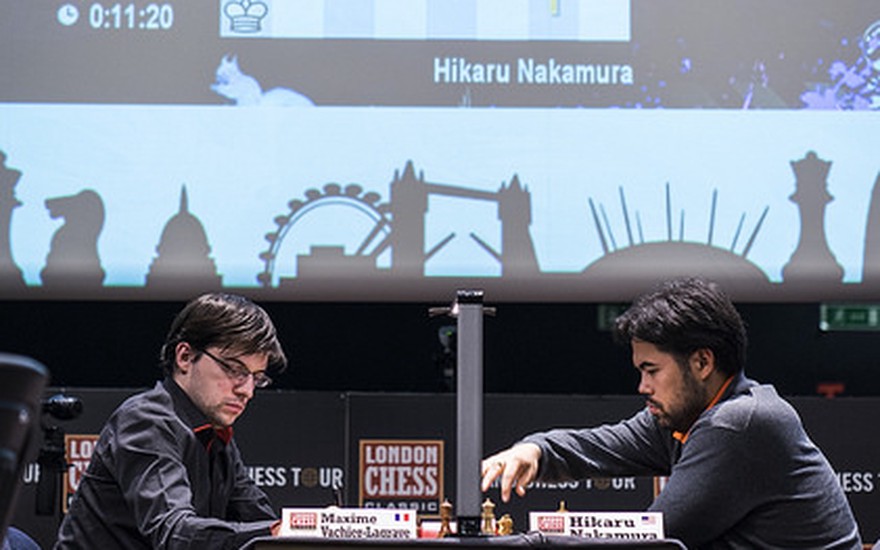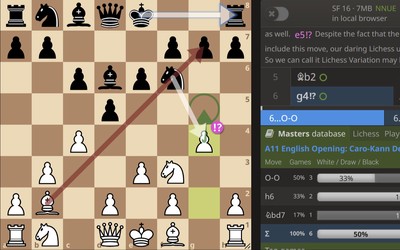
London Chess Classic: Round 7 "The Hikaru Strikes Back"
Highlights and action from Round 7For what the chess gods giveth, they also taketh. Yesterday, they gave us a day full of drama and excitement, with incredibly attacking chess and a number of decisive results. Today, in round 7 of the London Chess Classic, we received 4 draws, some of them over just after the Sofia rules and with very little contention in the positions. That's what you get, though, when three Queen Gambits, one Symmetrical English and one Najdorf Sicilian are played. There was only one decisive result, which surprisingly (and thankfully) was not against Topalov (I am thinking of Rocky IV here where (spoilers) Ivan Drago is beating Apollo Creed to a pulp and his friend is shouting at Rocky to "throw in the towel, he's taken enough punishment!")
The real highlight of the day came from Hikaru Nakamura vs Maxime Vachier-Lagrave. Nakamura, who lost in such splendour against Caruana's brilliancy yesterday, displayed a brilliancy of his own, with a highly similar -- if not essentially identical opening for the first 12 or 13 moves, showing that it is not only Caruana who can dominate in heavily theoretical openings. Nakamura's game very possibly might be one of his greatest, especially as he beat the Najdorf specialist at his own game.
Hikaru Nakamura (USA 2779) vs Maxime Vachier-Lagrave (FRA 2804)
Nakamura offers a Sicilian, which MVL -- the Sicilian specialist -- unreservedly accepts. For around 10 moves, both are blitzing out moves, very clearly in mainline Najdorf theory. Like yesterday, 6. Bg5 was played, and we had a very familiar position where white has a considerable kingside attack going by move 14. There are, however, some differences then from Caruana's brilliancy yesterday. Namely, MVL has developed his queenside more than Nakamura had done so yesterday, giving MVL threats along the light-squared diagonal of a8 -- h1, plus a battery of rook and queen pointing down to c2. In this position, MVL has more threats of counter play then Nakamura had yesterday.
Only once the queenside is developed, did MVL play the g5 push to break up white's centre. Now diverging completely from yesterday, and moving into novelties at the highest grandmaster level, Nakamura played 16. Qh3 (a move which has been played in this position by 2100 -- 2300s), so if 16...gxf5 17. g5 is played, there is a fork on black's knight on f6 and the h-pawn, which cannot take as it would drop a rook. The theoretical duel now seemed to be over, with both players out of their preparation and theory. This move -- 16. Qh3 -- particularly stumped MVL, who thought for around 30 minutes in this position.
After much deliberation, MVL played 16...Nc5, and the game became very sharp and very deep. It was an incredibly complex position which whilst the engines gave as drawn (so long as you played unnatural engine lines), either played really could have won if they made the slightest miscalculation. By move 25, however, it was really Nakamura's for the taking, with a well-placed dark squared bishop allowing a potential h-pawn push all the way to promotion. Nakamura's chess really impressed, with the beautiful 18. Nf5, inviting black to take a knight for no compensation other than long term positional gain, being truly something from a time before engine lines.
MVL could have played a magnificent swindle in a lost position by playing 32...Kh7 33. Rxg5 Rd8 after which black has drawing potential. If 34. Qxd8, black responds with ...Qxa3+ and black has a perpetual check. If white moves the queen off the d-file, there are again chances of perpetual with Rxd1+, or otherwise black enters a slightly more favourable endgame. With the hindsight of a powerful engine, it appears simple to see; otherwise, the position looks rather forlorn and no human would be able to see it unless explicitly told there was a chance of perpetual.
Nakamura was obviously delighted with a result which potentially puts him back in contention at placing in the top 3, although it would require some very fortunate games for him to overtake Wesley So and take the Grand Chess Tour.
https://lichess.org/study/QkqbvW0f/O3qdIk22
Anish Giri (NED 2771) vs Veselin Topalov (BUL 2760)
Giri opened with 1. c4 which transposed into a Queen's Gambit Declined set up. Play was solid from both sides, but neither felt particularly ambitious. Topalov, famous for his historic unrestrained aggression, had a very passive position where he was largely just reacting to white's play for the most part. Giri, on the other hand, set up a solid position -- not commanding or dominating, but he had a greater space advantage and had possibilities of contesting a draw.
It's difficult to criticise such a game, where the advantage to white is very slight and difficult to take advantage of, especially in a game which spread to just over 6 hours. It's a huge feat of concentration and patience to play for that long, and the numbers don't lie -- both players, in the entire game, made only an average of 9 centipawn loss. Regardless, it just feels as if white has the initiative, and could have played a bit more actively or taken a few more risks to get the win even if playing for a draw.
For example, a queen trade looks as if it would work more in white's favour than in blacks, as white could hold the position with just one knight and a king, leaving his other knight free to skirmish. Black, on the other hand, needs his knight to protect his light squared pawns, whereas his dark squared bishop could be constrained by the pawn structure more easily. White had plenty of time, and patience, however, so built up his position into the best he could for an eventual pawn push, which never came.
There was possibly one chance, if Giri had played 51. g5, attacking the kingside when black's queen was skirmishing -- and would take a couple of moves to move back over to the attacked side. With perfect computer play, it does take white up to a +50 advantage after 30 moves, but it's a huge ask for a human player to find such depth. Even so, 51. g5 does look fairly natural to play speculatively, as it would add pressure and push towards trying for a win, whilst still keeping possibilities of a draw in case of a miscalculation.
https://lichess.org/study/QkqbvW0f/8fpWbStd
Wesley So (USA 2794) vs Vladimir Kramnik (RUS 2809)
This was an interesting game for a number of reasons -- firstly, if Wesley So were to defeat Kramnik, he would have overtaken him in the live ratings to take the no. 3 spot. Secondly, So has spoken previously about how Kramnik is his chess idol, and how he grew up reading his books.
Kramnik played the Queen's Gambit Declined, almost his signature opening, which then rapidly escalated into a series of trades, having essentially all major material and queenside pawns off the board by move 20. Both were clearly playing for the draw, with Kramnik happy to be in 3rd place in the London Chess Classic, and So in 1st. On move 36, complying with the Sofia rules, there was a handshake to signal a draw.
Kramnik said he "just played his usual chess" seeing "no reason to risk myself". Kramnik explained that "Wesley So has improved enormously in this year, and is currently playing the most in form chess on this circuit, even the world. I see him as a huge contender to Magnus in the years to come." Praise truly cannot come higher than that, and it is understandable that Kramnik played to neutralise white as rapidly as possible.
https://lichess.org/study/QkqbvW0f/FtkKAoBY
Levon Aronian (ARM 2785) vs Viswanathan Anand (IND 2779)
Anand played a Queen's Gambit Accepted, and after an early queen swap by Anand it was clear that both were content to play for a draw. Most major material was traded off around move 20, and the last 7 moves were blitzed out by both players to hit the Sofia rules 30 move mark before a draw was offered in an equal position.
https://lichess.org/study/QkqbvW0f/stZCupbI
Michael Adams (ENG 2748) vs Fabiano Caruana (USA 2823)
This was a key game for Caruana, where a win could have potentially put him higher or equal to So. There was considerable tension throughout this match, with Caruana unwilling to let winning chances slip through his fingers too early. Although a Symmetrical English was played (with a strong Botvinnik pawn triangle for Caruana), Caruana equalised early on in the game and then went into a sharp line with 12...Nb6, an uncommon move, inviting white to disrupt black's pawn structure but simultaneously weakening white's light squares.
Adams did take the knight, choosing to weaken his light squares, and there was some sharp play. However, once Kramnik and So drew, Caruana seemed happy to draw in an opposite coloured bishop endgame.
Interestingly, Caruana will play So today in what could promise to be one of the games of the tournament as second and first place battle it out in what could let Caruana overtake So for the $65,000 prize money. A win or draw from So will all but secure his first place position, with a win leapfrogging him into 3rd best in the world.
https://lichess.org/study/QkqbvW0f/OGlw3CgK
Going into the 8th round, Wesley So remains the leader on 5/7, Caruana on 4.5/7, Kramnik and Nakamura tied third on 4/7, Aronian, Anand and Giri all on 3.5/7, MVL and Adams on 3/7 and Topalov on 1/7.
Theo Wait (Cynosure) is attending the London Chess Classic on behalf of lichess.org. He would like to thank Malcolm Pein, for arranging a press pass for lichess.org, and for organising such a brilliant competition. He would also like to thank his fellow staff members lukhas, FM lovlas, nojoke, bosspotato for proof reading, editing, and checking all aspects of this article. All photos by the talented Lennart Ootes.
More blog posts by Lichess

Lichess Game of the Month: March 24
Aggressive English/Reti system with 6.g4!?
Round 14: Gukesh and Zhongyi are officially the World Championship Challengers
A historic finish to the FIDE Candidates, as 17 year old Indian prodigy becomes the youngest World C…
Candidates Round 13: Gukesh takes the lead, Zhongyi pulls ahead
A massive day for the 17 year old Indian, as his chances to win the Candidates skyrockets, as Zhongy…
